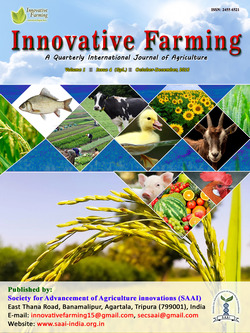
Phytochemical Screening of Solvent Extracts of Sweet Flag (SF) on Stored Product Insects
Saranya, M.*
Department of Agricultural Entomology, TNAU, Coimbatore-3, INDIA
S. J. Jeyarajan Nelson
Department of Agricultural Entomology, TNAU, Coimbatore-3, INDIA
M. Paramasivam
Department of Agricultural Entomology, TNAU, Coimbatore-3, INDIA
DOI: NIL
Keywords: Mechanical shaker, phytochemicals, sweet flag, stored insect
Abstract
Investigations were carried out to test the preliminary phytochemical screening of sweet flag (SF) rhizome (Acorus calamus L.) extracts at the Department of Agricultural Entomology, Agricultural College and Research Institute, Coimbatore. Sweet flag (SF) rhizome extracts were obtained in different extraction methods (soxhlet and mechanical shaker) using various solvents viz., hexane, ethyl acetate and ethanol. In soxhlet apparatus, 75.34, 8.56 and 29.56 g of SF oil extracts comprising of various compounds were obtained from 1200g of sweet flag rhizome powder, when extracted sequentially with hexane, ethyl acetate and ethanol, respectively. A quantity of 47.84, 27.92 and 18.00 g of SF oil extracts were consisting of different compounds obtained from 1200g of sweet flag rhizome powder, when extracted sequentially with hexane, ethyl acetate and ethanol, respectively using mechanical shaker. In soxhlet apparatus extraction, various solvent extract of SF showed the presence of tannins, flavonoids, steroid, terpenoid, glycosides, carbohydrates and protein. In mechanical shaker extraction, various solvent extract of SF showed the presence of alkaloids, phenolic compounds tannins, flavonoids, steroids, terpenoids, glycosides, carbohydrates and protein. Among the two extraction methods used, the soxhlet extraction method resulted in higher oil yield in compare to the extraction by mechanical shaker. Interestingly, the insecticidal activity was recorded higher in mechanical shaker extraction method. This could be attributed to the higher solubility of extractable bioactive components such as alkaloids, flavonoids, phenolic compounds, tannins, glycosides, carbohydrates and proteins that have insecticidal action. Phytochemicals have a synergistic effect that enhances the insecticidal action of solvent extracts of sweet flag.
Downloads
not found
Reference
Arunkumar, S. and Muthuselvam. 2009. Analysis of phytochemical constituents and antimicrobial activities of Aloe vera L. against clinical pathogens. World Journalof Agricultural Sciences, 5(5): 572-576.
Asha, V. and A.A. Kumar. 2015. Phytochemical investigations, extraction and thin layer chromatography of Acorus calamus Linn. International Journal Research Studies in BioSciences, 3(4): 18-22.
Edoga, H.O., D.E. Okwuand and B.O. Mbaebie. 2005. Phytochemicals constituents of some Nigerian medicinal plants. African Journal of Biotechnology, 4(7): 685-688.
Gaidhani, S.N., G.S. Lavekar, A.S. Juvekar, S. Sen, A. Singh and S. Kumari. 2009.
In-vitro anticancer activity of standard extracts used in ayurveda. Pharmacognosy Magazine, 5: 425-429.
Linna, L., W.I. Jingjie, S. Lei, Z. Wenjuan, D. Xiaoyan, W. Zhipen and Z. Yan. 2013. Asarone induces senescence in colorectal cancer cells by inducing lamin B1 Expression. Phytomedicine, 20: 512– 520.
Motley, T.J. 1994. The ethnobotany of sweet flag, Acorus calamus L. (Araceae). Economic Botany, 48(4): 397-412.
Neha, B., J. Honey, B. Ranjan and B. Mukesh. 2012. Pharmacognostical and preliminary phytochemical investigation of Acoruscalamuslinn. Asian Journal of Pharmaceutical Research, 2(1): 39-42.
Nelson, S.J., Y.S.J.T. Edward, P.M.M. David and P. Vivekanadhan. 2007. Rice - Sweet flag (Acorus calamus) intercropping for increasing the net return and thwarting insect pests settlement on rice. In:Proc. of the 2nd International Conference on Rice for the Future, 6-9 November 2007, Bangkok , Thailand.349-353pp.
Treare, G.E. and W.C. Evans. 1985. Pharmacognosy (17 edn.), BahiveTinal, London, pp: 14.
